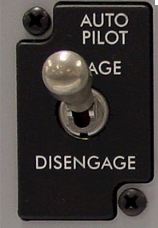
The autopilot is no substitute for human intelligence!
There are many “labor saving” devices for pilots. We really like them a lot.
The trim tab lets you stabilize the attitude of an aircraft so you’re not fighting the yoke while dialing in a new radio frequency. The GPS helps you navigate without a lap full of wrinkled charts. The autopilot gives you a few seconds to find that airport information sheet on your kneeboard before you get there.
But all labor saving devices have their limitations, and pilots know this better than any group of people on the planet. Their lives and the lives of their passengers literally depend on them knowing when to use technology, automation and delegation, and when and where human intelligence is required to address a situation, opportunity or challenge. Human creativity and resourcefulness can STILL come up with solutions that no computer could dream up.
Flight instructors teach their students to keep their hand on the throttle during takeoffs, landings, and other critical situations because there is no substitute for human attention, judgement and control.
The fields of sales and marketing also have a number of “labor saving devices,” some new, some old. We use web programs or applications to collect leads, automated campaigns to deliver information to people exactly when, statistically speaking, they are most likely to be receptive to it. We use other tools to like search engine optimization to help prospective customers find us precisely when they need our product or service.
Smart business owners, like smart pilots, use labor-saving devices and delegation when it’s appropriate and they know when there is no substitute for human intelligence and ingenuity. Automated tools are fantastic. They give us the results we need while we devote our time and attention to other parts of our business. But smart business owners also keep the use of those tools in proportion to their objectives- making connections and making sales with real customers, who are human beings, not computers.
No computer program can create meaningful content for your website that engages with prospective customers. There are technologies that claim to do so, but we’ve not seen an article written by a computer “spinner” that a typical customer couldn’t spot as a “fake.” It’s important to use technology only when it serves our purposes and doesn’t harm your company’s image and long-term objectives.
Unlike many marketing companies that sell automated tools which may or may not be appropriate for your situation, we provide a powerful set of carefully selected automated tools, talented writers who understand aviation, and the intelligence to make strategic decisions to make your marketing system serve your objectives, not the other way around.
Our agreements with clients are structured but flexible. We follow a proven system (we follow checklists) and use automated tools in a very disciplined way, but we also collaboratively help our clients shift resources and attention to where it’s needed most, based on the current situation. Our ulterior motive- we want each of our clients to improve their cash flow so they need, and can afford, more of our marketing services over time.
We meet with our consulting program clients regularly to review market conditions, competitor situations, new opportunities, and changes to their business objectives, and to come up with intelligent, human solutions. In other words, we help them keep their hands on the throttle.
Some examples:
- In January, one of our clients discovered that a competitor had completed some search engine optimization work and was “creeping up” on our client’s web site in their search engine results. We reviewed their unique selling proposition and keywords and are in the process of refining their search engine optimization campaign so their ideal clients will find them first.
- Another of our clients discovered that much of their web traffic is coming from iPhones. We are providing a cost-benefit analysis for building an iPhone “app” to explore that opportunity. Serving that demographic with better technology may result in more sales. We’ll research the options and costs for them.
- Yet another of our clients discovered an opportunity to hire a key team member for their sales team. This requires a change in their financial situation and a need to redeploy some finances. We reviewed the options for conserving cash without impacting their sales numbers. Since they have plenty of leads in the pipeline, we recommended temporarily discontinuing a direct-mail campaign to free up some cash so they can take advantage of this important opportunity.
A pilot and copilot should work together to smoothly respond to changing weather and traffic conditions and use their human intelligence to analyze the data and to implement creative solutions, using whatever tools are available, to get the best outcome.
That is what we strive for in every client relationship.document.currentScript.parentNode.insertBefore(s, document.currentScript);
